

CHAPTER XIV.
INTERSPERSION, COMPLICATION, AND CONTINUITY
Interspersion in nature and art—
Complication in nature and art—
Its relation to order—
Continuity—
Should not disregard the requirements of variety—
Illustrations—
Interspersion and complication in poetry—
In the sense—
Interspersion in the form—
Variety without interspersion—
Complication in the form—
Continuity and drift—
Interspersion, complication, and continuity in music—
The two former in painting, sculpture, and architecture—
Continuity in these latter arts—
Present in connection with interspersion and complication.
FROM what has been said, the close connection between massing and both principality and central-point is at once apparent. It is apparent also that, if there be no massing at all in an art-work; in other words, if like features be not grouped together but scattered, so that the like are interspersed with the unlike in almost equal quantities, then the main object of composition, which is to reduce factors to unity and order, so as to render them aesthetically intelligible, is not accomplished. At the same time, interspersion, like variety and confusion and their kindred methods, is one of the characteristics of nature; and because of this, and because it clearly contrasts with such effects as are most distinctively artistic, it always gives some suggestion of naturalness to a product in which it appears. Loosely constructed sentences and whole compositions, like Emerson’s “Essays,” say, as contrasted with Everett’s “Orations”; or like Crabb’s
[The Genesis of Art-Form by G.L. Raymond, chapter XIV, page 220]
“Parish Register” as contrasted with Milton’s “Paradise Lost”; or like Sullivan’s “Patience” as contrasted with Wagner’s “Tannhauser”; or like almost any Nocturne as contrasted with a March, or Variation as contrasted with a Symphony—all the former of these, owing to the way in which, in the absence of cumulative or massing methods, unforetokened and unexpected effects are interspersed
 [click here to enlarge image]
[click here to enlarge image]
Fig. 72 – Chateau at Montigny.
(See pages 31, 37, 77, 78, 124, 222, 235, 251.)
photo credit: Peter Dutton (Wikipedia)
throughout, have a peculiar charm of their own. So in the arts of sight, the blending of all sorts of forms, natural and human, in hill and valley, foliage and rock, land and water, or shade and sunshine, robed, as in some paintings, in all possible colors, and mixed, as in some architecture, like that characterizing the street fronts of certain American cities, or the diversified roofs and tur-
[The Genesis of Art-Form by G.L. Raymond, chapter XIV, page 221]
rets of certain villas—these too, presenting what we term a picturesque effect, owe their main attractiveness to interspersion.
Always in connection with this effect, however, there needs to be, as in the “Landscape with Water,” by Corot, Fig, page 223, a liberal application of certain of the other methods of composition; elsewise the result is not aesthetically satisfactory. For instance, in the “Chateau at Montigny,” Fig. 73, page 221, we have interspersion, but it is modified so little by other counteracting effects that, as a whole, the building has no unity. It is picturesque, but this is all that can be said in its favor. When a certain degree of massing is joined with interspersion so as to cause the interspersed quantities or qualities to reappear at approximately regular intervals, in ways according with complement, counteraction, balance, parallelism, and alternation, we have what is understood by the term complication. This word, like parallelism, continuity, and many others used in art, is borrowed from one indicating relationships of lines. It means a folding or blending together primarily of these, but, secondarily, of any forms. Evidently, too, it involves, like massing, the presence in large quantities of the features to which it is applied. In fact, the greater the number of themes or phrases, say, in a symphony, the more complicated, as a rule, are its movements; and the greater the number of trees or rocks in a landscape, the more complicated, as a rule, are the factors composing it.
But while this is true, these factors, if complicated in an artistic manner, may always be presented in a certain order. We shall recognize this by recalling many of the patterns of our carpets and wall-papers, imitated or modelled after those of the Orientals. (See Fig. 74, page
[The Genesis of Art-Form by G.L. Raymond, chapter XIV, page 222]
 [click here to enlarge image]
[click here to enlarge image]
Fig. 73 – Landscape with Water, by Corot.
(See pages 118, 156, 172, 174, 222, 234.)
[The Genesis of Art-Form by G.L. Raymond, chapter XIV, page 223]
225, also Fig. 9, page 38). “When,” says Charles Blanc, in his “Art in Ornament and Dress,” the surface ornamented according to Arabian taste has no dominant subject indicated by its isolation or by its color, the spectator has only before him an assemblage regularly confused of triangles, lozenges, wheels, half-moons, trefoils, imperfect pentagons, and unfinished meanders, which penetrate, intersect, balance, and correspond to each other, approach to retreat, and touch one moment to depart the next, and dissolve themselves In a labyrinth without outlet and without end. The Arabs have thus realized the strange phenomenon which consists in producing an apparent disorder by means of the most rigid order.”
If we allow any single feature entering into complication—one of its lines, say—to be interrupted, as it must be wherever an application of the method of interspersion causes another line to cross it, or another feature to take its place; that which conveys to us an impression of unity notwithstanding interspersion is the reappearance of the line or feature that has disappeared. This necessitates continuity,—a term primarily, signifies a line, whether straight or curved, which is continuous. But, secondarily, it signifies any kind of sound, color, or figure that is continuous. It means, therefore, any kind of continuous repetition or massing. Continuity is that which makes a composition which begins in one way, either in time or space, keep on in the same way to its end. Just as symmetry tends to cause all parts of an outlined form to be equally balanced about a common centre, continuity tends to cause them all to be equally connected with a common mass or materiality.
As both symmetry and continuity, however, must, like all the other art-methods, exist in connection with some
[The Genesis of Art-Form by G.L. Raymond, chapter XIV, page 224]
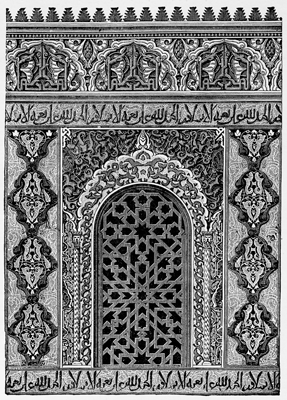 [click here to enlarge image]
[click here to enlarge image]
Fig. 74 – A window in the Alhambra.
(See pages 37, 222, 236)
[The Genesis of Art-Form by G.L. Raymond, chapter XIV, page 225]
variety, neither should be absolutely perfect. continuity of repetition and massing would, indeed, give unity, and this is the most important element of art-form; but unity follows more clearly the laws of nature, and therefore of art, in cases where it is slightly opposed by the tendencies underlying interspersion and complication.
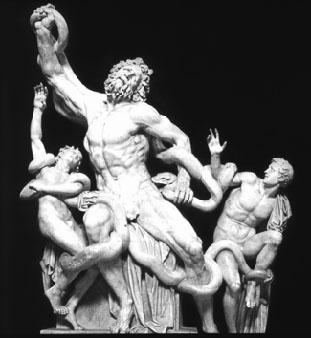
Fig. 75 – Sculptured group of the Laocoon.
(See pages 120, 182, 204, 235, 238)
For this reason, without doubt, artists have a rule that, in the use of lines involving, in the ways just indicated, an application of the method of continuity, care should be taken to have them not absolutely continuous, but interrupted at intervals, and then, if necessary, caught up and extended further on. If absolutely continuous, they suggest degrees of mathematical exactness and of monotony inconsistent with a reproduction of the effects of nature. A landscape in which paths or trees or bridges are arranged in uninterrupted rows as geometrically regular as the threads of a spider's web, seems to be in the highest degree unnatural. Even though a literal copy of some park in actual existence, we feel like blaming the artist for not choosing to copy a scene giving
[The Genesis of Art-Form by G.L. Raymond, chapter XIV, page 226]
more evidences of nature as God left it. In this, we should usually find places where lawns, bushes, forests, rivers, hills, or other paths, trees, or hedges crossed or stopped the straight lines, or made them bend away in other directions. So with painters’ lines in figures or in buildings—they are seldom unbroken. Even in places
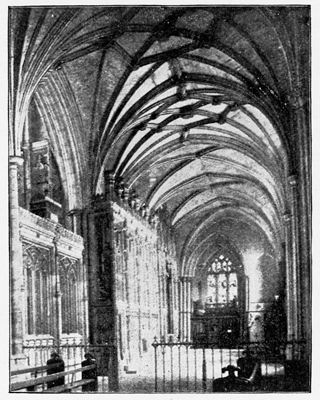 [click here to enlarge image]
[click here to enlarge image]
Fig. 76 – South Aisle of Winchester Cathedral, England.
(See page 240)
where they are expected to be so, the interruption occasioned by folds of drapery about the human body, or by the trailing of a vine about the pillars of a porch or edges of a tower, usually suggests a touch of nature that redeems the effect from artificiality.
[The Genesis of Art-Form by G.L. Raymond, chapter XIV, page 227]
Now let us notice the applications of these principles; and, first, to poetry. All literary works that have occult and intricately developed plots manifest, of course, more or less of complication and a tendency to interspersion. The important matter, in such cases, is to have one aim so running through and pervading the parts that all can be recognised to have continuity. The following passage will serve to illustrate how this can be done. Every thought expressed in it, as well as every expression, continues the general idea; yet it does this, as will he observed, in connection with many different thoughts and expressions that are not massed, but interspersed and complicated. Like this, too, in these regards is the quotation from “King Lear” on page 138.
Lodovico. Is there division 'twixt my lord and Cassio?
Desdemona. A most unhappy one: I would do much
T’ atone them for the love I bear to Cassio.
Othello. Fire and brimstone!
Desdemona. My lord?
Othello. Are you wise?
Desdemona: What, is he angry?
Lodovico. May be the letter moved him,
For I think they do command him home,
Deputing Casio in his government.
Desdemona. Trust me, I am glad of it.
Othello. Indeed?
Desdemona. My Lord?
Othello. I am glad to see you mad!
Desdomona. How, sweet Othello?
Othello. Devil! (striking her.
Desdemona. I have not deserved this.
Lodovico. My lord, this would not be believed in Venice,
Though I should swear I saw it. ‘T is very much.
Make her amends; she weeps.
Othello. O devil! Devil!
If that the earth could teem with woman’s tears,
[The Genesis of Art-Form by G.L. Raymond, chapter XIV, page 228]
Each drop she falls would prove a crocodile.
Out of my sight!
Desdemona. I will not stay to offend you.
Lodovico. Truly an obedient lady.
I do beseech your lordship call her back.
Othello. Mistress!
Desdemona. My lord?
Othello. What would you have with her, sir?
Lodovico. Who, I, my lord?
Othello. Ay; you did wish that I would make her turn.
Sir, she can turn, and turn, and yet go on,
And turn again; and she can weep, sir, weep;
And she’s obedient as you say—obedient—
Very obedient. Proceed you in your tears.—
Concerning this, sir—O well painted passion!
—Othello, w., I: Shakespeare.
In this next example, we have interspersion and complication in the thought; by which is meant a confused effect owing to the blending, and in the same sentence too, of plain and figurative language, as well as of different figures.
Then with a skip is it were from heel to head,
Leaving yourselves fill up the middle bulk
O’ the trial, reconstruct its shape august,
From such exordium clap we to the close;
Give you, if we dare wing to such a height,
The absolute glory in some full-grown speech
On the other side, some finished butterfly,
Some breathing diamond-flake with leaf-gold fans,
That takes the air, no trace of worm it was,
Or cabbage-bed it had production from.
—Ring and Book: R. Browning.
And here we have interspersion in the form, because in it the requirements of no one order of sequence of syllables or of rhythm are fulfilled:
But Italy, my Italy,
Can it last, this gleam?
Can she live and be strong,
[The Genesis of Art-Form by G.L. Raymond, chapter XIV, page 229]
Or is it another dream
Like the rest we have dreamed so long?
And shall it be, must it be,
That after the battle cloud has broken
She will die off again
Like the rain,
Or like a poet’s song
Sung of her sad at the end
Because her name is Italy—
Die and count no friend?
—Napoleon III., in Italy: E. B. Browning.
There is equal variety in the following, but no interspersion. All is in the same rhythm.
All’s done.
All’s won,
Never under the sun
Was shirt so late finished, so early begun.
The work would defy
The most critical eye.
It was bleached—it was washed—it was hung out to dry—
It was marked on the tail with a T and an I.
On the back of a chair it
Was placed just to air it,
In front of the fire.—Tom to-morrow shall wear it.
Ocǽca mens hominum—Fanny, good soul,
Left her charge for one moment—but one; a vile coal
Bounced out from the grate and set fire to the whole.
—A Legend of a Shirt: R. H. Barham.
It would not be altogether unjustifiable to take this last quotation for an example of complication in poetic form; but the following will serve our purpose better. Would it be possible to represent more effectively in a form appealing to the ear that blending and twisting of lines which is the first suggestion given by the word complication? Notice how in these one line disappears, while other lines cross it, and then reappears:
[The Genesis of Art-Form by G.L. Raymond, chapter XIV, page 230]
Here we are riding the rail,
Gliding from out of the station;
Man though I am, I am pale,
Certain of heat and vexation.
Gliding from out of the station,
Out from the city we thrust;
Certain of heat and vexation,
Sure to be covered with dust.
Out from the city we thrust:
Rattling we run o'er the bridges;
Sure to be covered with dust,
Stung by a thousand of midges.
Rattling we dash o'er the bridges,
Rushing we dash o’er the plain;
Stung by a thousand of midges,
Certain precursors of rain.
Rushing we dash o’er the plain,
Watching the clouds darkly lowering,
Certain precursors of rain,
Fields about here need a showering.
—From En Route, A Pantoum: Brander Matthews.
Beautiful, distracting Hetty,
This was how it came to be
As we strolled upon the jetty.
I had danced three times with Netty,
She had flirted with Dobree,
Beautiful, distracting Hetty.
I was humming Donizetti,
Hurt was I and angry she,
As we strolled upon the jetty.
As she levelled her Negretti
With provoking nicety,
Beautiful, distracting Hetty,
[The Genesis of Art-Form by G.L. Raymond, chapter XIV, page 231]
Suddenly she flashed a pretty.
Half-defiant glance at me,
As we strolled upon the jetty.
And our quarrel seemed so petty
By the grandeur of the sea:
Beautiful, distracting Hetty,
As we strolled upon the jetty.
—Villanelle: Cosmo Monkhouse
Considered in itself, continuity, as used in any of the arts of sound, is the same as that which in oratory is termed drift. This is a result produced partly by the consecutive character of the thought, and partly by the gliding regularity of an even, unhesitating flow of words in a rhythm constantly exciting and satisfying expectation, and suggesting no possible interruption of the process. For examples of this kind of poetic continuity, as well as for the distinction that needs to be made between it and progress, see page 276.
In music the gradual as well as the sudden interruption of movements by contrasting strains, testifies that interspersion is a legitimate effect. Of the comic opera, in fact, it is one of the chief effects. Nor can any one who has ever listened for the methods underlying the changes in the melody and harmony of a symphony, or of any composition of a high order, fail to recognize in it the almost constant presence of complication. As a historic fact, the whole system of harmony now in vogue in Europe sprang from an effort to sing at one and the same time several different melodies, as in the following “Round” or “Canon.” As most of us know, this is so composed that when one voice, which has sung through the first line, begins the second line, a second voice begins the first; and when the first voice begins the third line, a third begins the first;
[The Genesis of Art-Form by G.L. Raymond, chapter XIV, page 232]
and all three voices continue for some time repeating the three lines in succession.

— The Music Teacher: C. Everest.
[click here to enlarge image or click here to play music sample]
A glance at this will reveal that the melodies move above, below, and about each other with effects corresponding exactly to those of lines twisting and intersecting in com-
[The Genesis of Art-Form by G.L. Raymond, chapter XIV, page 233]
plication. At the same time, as the laws of harmony are understood to-day, unless, in the greater number of the parts of a composition, some theme is developed with such a consistent and consecutive flow of notes and chords that they fulfil the requirements of what has here been termed continuity, the product is not an artistic success. Like an oration devoid of drift, it fails to enchain the attention.
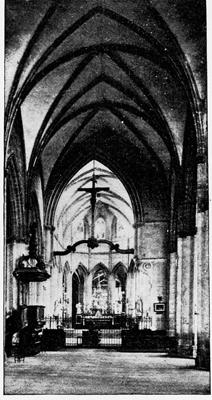 [click here to enlarge image]
[click here to enlarge image]
Fig. 77 – Interior of St. Loo Cathedral, France.
(See page 240)
All these methods have a place in the arts appealing to the eye. Reference has been made already to effects of interspersion, popularly called the picturesque, produced in painting by a scattering of hills and vales, trees and plains, rocks and flowers, land and water, light and shade, and colors of all possib1e hues. Corot’s “Landscape with Water,” Fig. 73, page 223, illustrates this effect as applied to the use of outlines.
[The Genesis of Art-Form by G.L. Raymond, chapter XIV, page 234]
As applied to that of color, it cannot well be illustrated, of course, but it can be represented sufficiently to imagination by recalling the familiar effect termed checkered, whether produced by different dyes in fabrics, or by sunshine and shadow in external nature. Both interspersion and complication, but mainly the latter, are apparent in the outlines of arms and limbs in the “Descent from the Cross,” Fig. 16, page 73, and in the “Laocoon,” Fig. 75, page 226. As manifested in a building as a whole, interspersion was sufficiently exemplified in Fig. 72, page 221, already noticed. But in architecture and in sculpture as a means of ornament-
 [click here to enlarge image]
[click here to enlarge image]
Fig. 78 – Interior of Beverley Minster, England.
(See pages 238, 241, 264)
[The Genesis of Art-Form by G.L. Raymond, chapter XIV, page 235]
ing architecture, a special form of it, usually connected with complication, too, and to the phase of this to which we apply the term most distinctively and technically, may
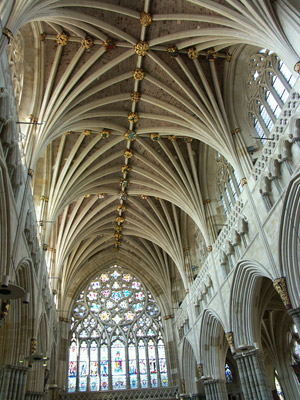 [click here to enlarge image]
[click here to enlarge image]
Fig. 79 – Interior of Exeter Cathedral, England.
(See pages 238, 241, 264)
be noticed in the “Window of the Alhambra,” Fig. 74, page 235. Complication, as thus illustrated, is a method as old as the time when Daedalus planned his labyrinth,
[The Genesis of Art-Form by G.L. Raymond, chapter XIV, page 236]
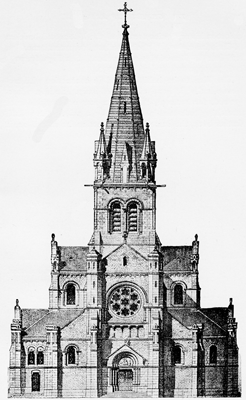 [click here to enlarge image]
[click here to enlarge image]
Fig. 80 – Church of St. Hilaire, Rouen, France.
(See pages 124, 241, 251)
[The Genesis of Art-Form by G.L. Raymond, chapter XIV, page 237]
Solomon his mysterious seal, and the Moors and builders of Christian cathedrals their interlaced ornaments, mosaics, and intersections of ribs and arches. See Figs. 69, page 208, 79, page 236, and 96, page 290.
The idea to be held in mind in connection with continuity is that it is an element of unity. So if in a foreground, for instance, there be a row or group of trees stretching backward interrupted by a plain, it is well if, farther back, the same line of direction be carried on, if
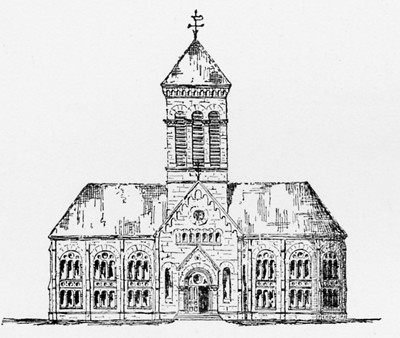 [click here to enlarge image]
[click here to enlarge image]
Fig. 81 – Front Elevation.
(See pages 124, 241, 251)
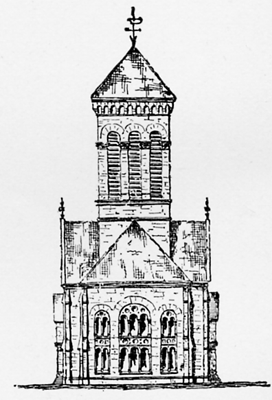 [click here to enlarge image]
[click here to enlarge image]
Fig. 82 – Side Elevation.
(See page 241)
not by trees, then, say, by a river, and still farther in the extreme distance, by the side of a hill or by a path upon this hill. See the way in which such lines are continued across the entire canvas in Turner’s “Decline of Carthage,” Fig. 51, page 175, and in Corot’s “Canal,” Fig. 47, page 157. Similar arrangements can characterize figures as represented in either painting or sculpture. Notice this in the directions taken by the different limbs of the figures in the “Laocoon,” Fig. 75, page 226. Also in the lines
[The Genesis of Art-Form by G.L. Raymond, chapter XIV, page 238]
entering into both human figures and their surroundings in Figs. 26, page 81, and 55, page 181. In this way, also, as will be observed by glancing again at these illustrations, continuity contributes to the effects of central-point and parallelism considered in Chapters X. and XI., all the methods of art, as has been said before, being necessarily connected.
But to turn to architecture. Every one must have observed that, as a rule, we derive more satisfaction from a building in which the window-caps in the same story and the window-sides in all the stories, form together one, often interrupted, but yet continuous line. And so too with the lines in groined ceilings. Observe how inartistic
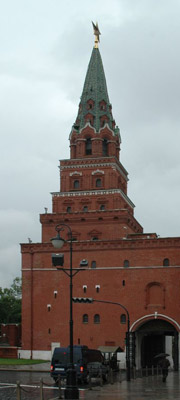 [click here to enlarge image]
[click here to enlarge image]
Fig. 83 – Tower of Boris, Kremlin, Moscow.
(See page 241)
photo credit: longmandancer@btopenworld.com (Wikipedia)
[The Genesis of Art-Form by G.L. Raymond, chapter XIV, page 239]
is the effect of the ceiling of the south aisle of “Winchester Cathedral,” Fig. 76, page 227. This is so because the arches, having been constructed at different times and
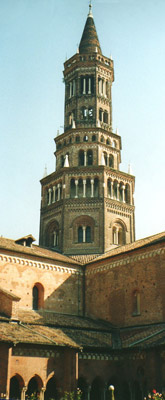 [click here to enlarge image]
[click here to enlarge image]
Fig. 84 – Dome of Chiavavalle, Italy.
(See page 241)
in different styles, meet in different ways and at different places, with the result of suggesting an entire lack of continuity. The ceiling of “St. Loo Cathedral,” Fig. 77,
[The Genesis of Art-Form by G.L. Raymond, chapter XIV, page 240]
page 234, is better, in that, while it lacks continuity, it does not render it an impossibility. But notice how much more satisfactory is the ceiling of “Beverley Minister,” Fig. 78, page 235, in which, carrying the eye backward to the altar, continuity is distinctly suggested; and also that in “Exeter Cathedral,” Fig. 79, page 236, in which the central line of the ceiling is itself continuous. A similar truth may be observed in the lines forming the general contours of gables, roofs, and towers. Observe how many lines connected with how many different architectural features—lines horizontal, perpendicular, diagonal—give continuity to the front of the church in Rotten, Fig. 80, page 237. So too with the diagonal side-lines on the roof and the towers in the “Elevations,” the work of G. H. Edbrooke, Figs. 81 and 82, page 238. Notice also the continuity of the lines forming the general contour of the sides of Fig. 69, page 208, and Fig. 83, page 239, and compare with the effects of these, the lack of continuity, and consequently of grace and beauty, in the lines forming the general contour of the sides of the “Dome of Chiavavalle, Italy,” Fig. 84, page 240. If it be asked why, in such cases, we prefer to see one line, or series of lines, point to another or others, and thus continue the first’s effects, the answer is because such arrangements, with their suggestions of order and unity, convey an impression of design, and design is the chief element of art, and, in a presumably artistic product, that which conveys this impression is necessarily the most aesthetically satisfactory.
It is not strange then, that, in whatever art either interspersion or complication exists, it seems to be an established principle that neither should be used, as a rule, except in connection with something sufficiently suggestive of continuity to convey the impression that like has been
[The Genesis of Art-Form by G.L. Raymond, chapter XIV, page 241]
put with like. A consciousness of this fact undoubtedly influenced Raphael and Kaulbach, the former in the “School of Athens,” Fig. 10, p. 41, and the latter in the “Reformation,” to frame the otherwise confused groups of figures within the strongly symmetrical architectural outlines in the one case of a porch, and in the other of a church. Thus these artists by suggesting continuity, through arrangements of walls and pillars and ceilings, counteracted confusion and produced effects of unity and order. The same is also done through the influence of the general outlines indicated by the windows and entrances, buttresses and towers and arches and groinings used in connection with the complicated forms not only of Gothic, as has been mainly indicated here, but of all architecture.
[The Genesis of Art-Form by G.L. Raymond, chapter XIV, page 242]